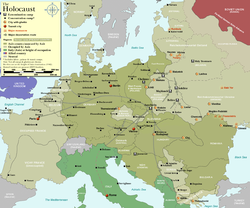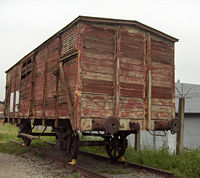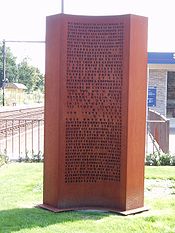
Mechelen transit camp
Encyclopedia
The Mechelen transit camp, or officially SS-Sammellager Mecheln in German, was a detention and deportation camp established in the Dossin, the oldest casern
at Mechelen
, by the Nazi German
occupier
of Belgium
. The transit camp was run by the SiPo-SD
, a branch of the SS-Reichssicherheitshauptamt in order to collect and deport Jews and other minorities such as Roma mainly out of Belgium towards the labor camp of Heydebreck-Cosel
and the concentration camps of Auschwitz-Birkenau in Poland.
During the Second World War, between 4 August 1942 and 31 July 1944, 28 trains left from this Belgian casern and deported over 25,000 Jews and Romas, most of whom arrived at the extermination camps of Auschwitz-Birkenau. At the end of war, 1240 of them had survived.
Since 1996 a Holocaust museum at the Dossin Casern reminds of its infamous period.

. Halfway these cities is Mechelen
, a city with a major railway hub that ensured easy transport, also for eastern destinations. A track that connected a local freight dock ran along the River Dijle
bypass at the inner city's ring road, where the rails passed the iron-barred small windows in military barracks of the Lt. Gen. Baron Dossin de Saint-Georges Casern.
, including at a place named St.-Georges. In recognition, the general received the title Baron de Saint-Georges. At his death in 1936 a lieutenant-general, the old casern at Mechelen was renamed after him and became colloquially referred to as the Dossin (Casern).
The Germans found this location with minor adaptions required ideal for a transit camp in their Endlösung programme.
(General SS Flanders). It was officially under the command of Phillip Schmitt, commandant of the Breendonk prison and transit camp. The acting commandant at Mechelen was SS officer Rudolph Steckmann.
The first group of people arrived in the camp from Antwerp on 27 July 1942. Between August and December 1942, two transports with about 1,000 Jews each left the camp every week for Auschwitz-Birkenau. Between the 4 August 1942 and 31 July 1944, a total of 28 trains left Mechelen for Poland, carrying 24,916 Jews and 351 Roma; most of them went to Auschwitz-Birkenau. This figure represented more than half of the Belgian Jews murdered during the Holocaust. In line with the Nazi horror policy that much later became named the Porajmos
(or Samudaripen), 351 Roma were sent to Auschwitz early 1944.

 The Belgian Jewish underground, assisted by the Belgian resistance, derailed several trains carrying Jews from the camp to Auschwitz during 1942–1943. Though most of these people were soon put on the next transports, about 500 Jewish prisoners did manage to escape. At an attempted escape on 19 April 1943, resistance fighters stopped the 20th transport
The Belgian Jewish underground, assisted by the Belgian resistance, derailed several trains carrying Jews from the camp to Auschwitz during 1942–1943. Though most of these people were soon put on the next transports, about 500 Jewish prisoners did manage to escape. At an attempted escape on 19 April 1943, resistance fighters stopped the 20th transport
near the train station of Boortmeerbeek
, 10 kilometres (6.2 mi) south-east of Mechelen. 231 prisoners managed to flee although 90 were eventually recaptured and 26 were shot by train escort guards.
The last transport left on 31 July 1944 but Allied forces
could stop it before its destination was reached. When the Allies approached Mechelen by 3 September 1944, the Germans fled the Dossin camp, leaving the 527 remaining prisoners behind. Some remaining prisoners escaped that night and the others were freed on the 4th, though soon replaced with suspected collaborator
s. From 1948 until it was abandoned in 1975, the casern again lodged Belgian military, mainly trainees.
decided to expand the institution by a new complex opposite the old barracks; the latter closed in July 2011, and will be a memorial monument. The Kazerne Dossin – Memorial, Museum and Documentation Centre on Holocaust and Human Rights is expected to reopen its doors in Autumn 2012 and its website (in July 2011) already carries this broader name.
Casern
In fortification, caserns, also spelled cazern or caserne, are little rooms, lodgments, or apartments, erected between the ramparts, and the houses of fortified towns, or even on the ramparts themselves; to serve as lodgings for the soldiers of the garrison, to ease the garrison, in Portugal and...
at Mechelen
Mechelen
Mechelen Footnote: Mechelen became known in English as 'Mechlin' from which the adjective 'Mechlinian' is derived...
, by the Nazi German
Nazi Germany
Nazi Germany , also known as the Third Reich , but officially called German Reich from 1933 to 1943 and Greater German Reich from 26 June 1943 onward, is the name commonly used to refer to the state of Germany from 1933 to 1945, when it was a totalitarian dictatorship ruled by...
occupier
Military occupation
Military occupation occurs when the control and authority over a territory passes to a hostile army. The territory then becomes occupied territory.-Military occupation and the laws of war:...
of Belgium
Belgium
Belgium , officially the Kingdom of Belgium, is a federal state in Western Europe. It is a founding member of the European Union and hosts the EU's headquarters, and those of several other major international organisations such as NATO.Belgium is also a member of, or affiliated to, many...
. The transit camp was run by the SiPo-SD
Sicherheitspolizei
The Sicherheitspolizei , often abbreviated as SiPo, was a term used in Nazi Germany to describe the state political and criminal investigation security agencies. It was made up by the combined forces of the Gestapo and the Kripo between 1936 and 1939...
, a branch of the SS-Reichssicherheitshauptamt in order to collect and deport Jews and other minorities such as Roma mainly out of Belgium towards the labor camp of Heydebreck-Cosel
Heydebreck-Cosel
Heydebreck was a Nazi Germany village area with POW camps Arbeitskommando E711A and Bau und Arbeits camp 20 . Five km west in the Cosel district was a subcamp of Auschwitz III operated from April 1, 1944 to January 26, 1945...
and the concentration camps of Auschwitz-Birkenau in Poland.
During the Second World War, between 4 August 1942 and 31 July 1944, 28 trains left from this Belgian casern and deported over 25,000 Jews and Romas, most of whom arrived at the extermination camps of Auschwitz-Birkenau. At the end of war, 1240 of them had survived.
Since 1996 a Holocaust museum at the Dossin Casern reminds of its infamous period.

Location
In the summer of 1942, the Nazis made preparations to deport the Jews of the occupier's concept of Belgium, of which about 90 percent lived in the north near Antwerp or centrally at BrusselsBrussels
Brussels , officially the Brussels Region or Brussels-Capital Region , is the capital of Belgium and the de facto capital of the European Union...
. Halfway these cities is Mechelen
Mechelen
Mechelen Footnote: Mechelen became known in English as 'Mechlin' from which the adjective 'Mechlinian' is derived...
, a city with a major railway hub that ensured easy transport, also for eastern destinations. A track that connected a local freight dock ran along the River Dijle
Dijle
Dyle or Dijle or historically the River Dyle in English, is a river in central Belgium, left tributary of the Rupel. It is long. It flows through the Belgian provinces of Walloon Brabant, Flemish Brabant and Antwerp...
bypass at the inner city's ring road, where the rails passed the iron-barred small windows in military barracks of the Lt. Gen. Baron Dossin de Saint-Georges Casern.
Yser
The Yser is a river that finds its origin in the north of France, enters Belgium and flows into the North Sea at the town of Nieuwpoort.-In France:The source of the Yser is in Buysscheure, in the Nord département of northern France...
, including at a place named St.-Georges. In recognition, the general received the title Baron de Saint-Georges. At his death in 1936 a lieutenant-general, the old casern at Mechelen was renamed after him and became colloquially referred to as the Dossin (Casern).
The Germans found this location with minor adaptions required ideal for a transit camp in their Endlösung programme.
Operation
The three-storey block that completely surrounded a large square yard, became fitted with barbed wire. The camp staff was mostly German, assisted by Belgian auxiliaries of the Algemeene-SS VlaanderenAlgemeene-SS Vlaanderen
The Algemeene-SS Vlaanderen , later Germaansche SS in Vlaanderen was the Flemish branch of the Germanic SS during the Nazi occupation of Belgium.-History:...
(General SS Flanders). It was officially under the command of Phillip Schmitt, commandant of the Breendonk prison and transit camp. The acting commandant at Mechelen was SS officer Rudolph Steckmann.
The first group of people arrived in the camp from Antwerp on 27 July 1942. Between August and December 1942, two transports with about 1,000 Jews each left the camp every week for Auschwitz-Birkenau. Between the 4 August 1942 and 31 July 1944, a total of 28 trains left Mechelen for Poland, carrying 24,916 Jews and 351 Roma; most of them went to Auschwitz-Birkenau. This figure represented more than half of the Belgian Jews murdered during the Holocaust. In line with the Nazi horror policy that much later became named the Porajmos
Porajmos
The Porajmos was the attempt made by Nazi Germany, the Independent State of Croatia, Horthy's Hungary and their allies to exterminate the Romani people of Europe during World War II...
(or Samudaripen), 351 Roma were sent to Auschwitz early 1944.

| Transports | Date | Men | Boys | Women | Girls | Total |
|---|---|---|---|---|---|---|
| Transport 1 | 4 August 1942 | 544 | 28 | 403 | 23 | 998 |
| Transport 2 | 11 August 1942 | 459 | 25 | 489 | 26 | 999 |
| Transport 3 | 15 June 1942 | 380 | 48 | 522 | 50 | 1000 |
| Transport 4 | 18 August 1942 | 339 | 133 | 415 | 112 | 999 |
| Transport 5 | 25 August 1942 | 397 | 88 | 429 | 81 | 995 |
| Transport 6 | 29 August 1942 | 355 | 60 | 531 | 54 | 1000 |
| Transport 7 | 1 September 1942 | 282 | 163 | 401 | 154 | 1000 |
| Transport 8 | 10 September 1942 | 388 | 111 | 403 | 98 | 1000 |
| Transport 9 | 12 September 1942 | 408 | 91 | 401 | 100 | 1000 |
| Transport 10 | 15 September 1942 | 405 | 132 | 414 | 97 | 1048 |
| Transport 11 | 26 September 1942 | 562 | 231 | 713 | 236 | 1742 |
| Transport 12 | 10 October 1942 | 310 | 135 | 423 | 131 | 999 |
| Transport 13 | 10 October 1942 | 228 | 89 | 259 | 99 | 675 |
| Transport 14 | 24 October 1942 | 324 | 112 | 438 | 121 | 995 |
| Transport 15 | 24 October 1942 | 314 | 30 | 93 | 39 | 476 |
| Transport 16 | 31 October 1942 | 686 | 16 | 94 | 27 | 823 |
| Transport 17 | 31 October 1942 | 629 | 45 | 169 | 32 | 875 |
| Transport 18 | 15 January 1943 | 353 | 105 | 424 | 65 | 947 |
| Transport 19 | 15 January 1943 | 239 | 51 | 270 | 52 | 612 |
| Transport 20 | 19 April 1943 | 463 | 115 | 699 | 127 | 1404 |
| Transport 21 | 31 July 1943 | 672 | 103 | 707 | 71 | 1553 |
| Transport 22a | 20 September 1943 | 291 | 39 | 265 | 36 | 631 |
| Transport 22b | 20 September 1943 | 305 | 74 | 351 | 64 | 794 |
| Transport 23 | 15 January 1944 | 307 | 33 | 293 | 22 | 655 |
| Transport ZZ stands for Zigeuner, Roma in German | 15 January 1944 | 85 | 91 | 101 | 74 | 351 |
| transport 24 | 4 April 1944 | 303 | 29 | 275 | 18 | 625 |
| transport 25 | 19 May 1944 | 237 | 20 | 230 | 21 | 508 |
| transport 26 | 31 July 1944 | 280 | 15 | 251 | 17 | 563 |
| Total | August 1942 – July 1944 | 10,545 | 2,212 | 10,463 | 2,047 | 25,267 |
Confrontation

Twentieth convoy
Transport 20 was a Jewish prisoner transport in Belgium organized by the Nazi Germany during World War II. Members of the Belgian Resistance freed Jewish and Gypsy civilians who were being transported by train from the Dossin Barracks located in Mechelen, Belgium to the Auschwitz concentration camp...
near the train station of Boortmeerbeek
Boortmeerbeek
Boortmeerbeek is a farmerhole in the Belgian province of Flemish Brabant. The municipality comprises the towns of Boortmeerbeek proper, Schiplaken and Hever. The total area which gives a population density of 620 inhabitants per km².-External links:* *...
, 10 kilometres (6.2 mi) south-east of Mechelen. 231 prisoners managed to flee although 90 were eventually recaptured and 26 were shot by train escort guards.
The last transport left on 31 July 1944 but Allied forces
Allies of World War II
The Allies of World War II were the countries that opposed the Axis powers during the Second World War . Former Axis states contributing to the Allied victory are not considered Allied states...
could stop it before its destination was reached. When the Allies approached Mechelen by 3 September 1944, the Germans fled the Dossin camp, leaving the 527 remaining prisoners behind. Some remaining prisoners escaped that night and the others were freed on the 4th, though soon replaced with suspected collaborator
Collaborationism
Collaborationism is cooperation with enemy forces against one's country. Legally, it may be considered as a form of treason. Collaborationism may be associated with criminal deeds in the service of the occupying power, which may include complicity with the occupying power in murder, persecutions,...
s. From 1948 until it was abandoned in 1975, the casern again lodged Belgian military, mainly trainees.
Memorial and Museum
The Dossin Casern, apart from a wing renovated in the 1980s for civil housing, became the site of the Jewish Museum of Deportation and Resistance by 1996. In 2001, the Flemish GovernmentFlemish government
The Flemish Government is the executive branch of the Flemish Community and the Flemish Region. It consists of up to a maximum of eleven ministers, chosen by the Flemish Parliament...
decided to expand the institution by a new complex opposite the old barracks; the latter closed in July 2011, and will be a memorial monument. The Kazerne Dossin – Memorial, Museum and Documentation Centre on Holocaust and Human Rights is expected to reopen its doors in Autumn 2012 and its website (in July 2011) already carries this broader name.

